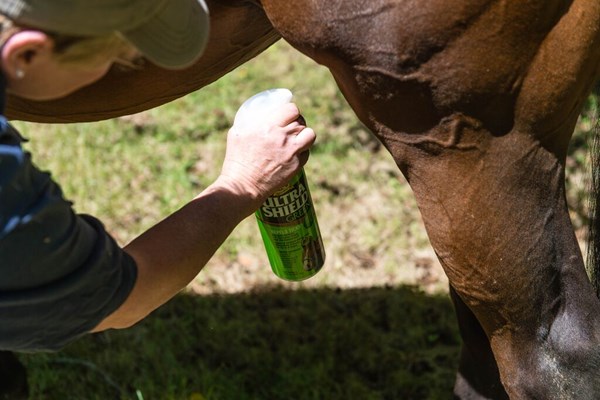
Let’s face it: If you don’t take the proper precautions, your horse is doomed to be harassed by swarms of flying, stinging, biting pests come warmer weather.
Called “a divell or familiar” in Scot’s 1584 Discoverie of Witchcraft, the fly is insidious, merciless, disease-spreading, disgusting and out to madden its equine victims.
He’s everywhere, and he takes different forms. You might not encounter tsetse flies (Glossina) outside of Africa, for example, but Trypanosoma, a disease agent transmitted by that notorious pest, inflicts neurological damage in other regions as well, thanks to horse flies (Tabanidae), known for their large size and painful bite, and stable flies (Stomoxys).
The stable fly occupies a special place in this rogues’ gallery. A common pest with blood-feeding tendencies, he goes for horses’ lower legs, resulting in a lot of stomping (and loosened shoes, to boot). Pity the poor lame horse who cannot even manage a stomp to rid himself of this devil!
The black fly or “buffalo gnat” (Simuliidae) is a nearly universal tormentor, as are the 800-plus species of Culicoides, otherwise known by rather innocuous-sounding nicknames like “midges,” “punkies” and “no-see-ums.” Though they’re tiny, all of these mini-flies pack a wallop, carrying disease organisms, parasitic worms and the potential for allergic dermatitis.
The blood-sucking horn fly (Haematobia irritans) infests the cooler regions of both northern and southern hemispheres, but is generally only a nuisance to horses if they’re pastured near cattle. Then there are the warble fly (Hypodermatidae) and the bot fly (Gasterophilus intestinalis and G. hemorrhoidalis), which flourish in just about all climates. The bot fly has the audacity to lay its eggs right on a horse’s coat, generally on the legs. So when a horse licks his legs, he ingests the eggs, after which they mature into larvae in the horse’s stomach lining.
Anywhere there are horses, you’ll also find the face fly (Musca autumnalis), which feeds on eye and mouth secretions, and the house fly (M. domestica), which favors horse manure, facial secretions and wounds. If you’re “down under,” torturing duties fall to their continent-specific relative, the Australian bush fly.
Last but not least is the vicious deer fly, of the genus Chrysops/ family Tabanidae, with its trademark banded wings. It’s the female of this species that is known for its stinging, cross-shaped incisions, which enable it to drink blood. Usually encountered in wooded or wet, low-lying areas, the deer fly is as much a scourge to cattle, wildlife and humans as it is to horses.
For such tiny creatures, flies wield an inordinate amount of power, often sending horses into stampedes or causing them to rear, kick out or stand in ponds for hours in order to escape them.
Horses will bite themselves to ward off flies or rub themselves raw to relieve the itch of fly-induced dermatitis. They will even drag themselves along on their bellies to assuage the pain caused by fly-transmitted worms.
Add to this the stress, depression and weight loss that can result from fly infestations, and you’re looking at a serious problem. Indeed, fly-induced ailments can persist long
after fly season.
Have you heard enough yet?
The good news is that, as bad as it sounds, not all of these types of flies are likely to descend on your horse at once. In general, eradicating wetness and rot will make your facility less hospitable to these little devils, as will instituting a well-researched and thorough fly control program. So get to it!






